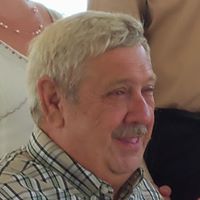Charles L Saylor
age ~76
from Bear, DE
- Also known as:
-
- Charles L Porter
Charles Saylor Phones & Addresses
- Bear, DE
- Gainesville, FL
- 203 Olga Rd, Wilmington, DE 19805 • (302)9957985
- Elsmere, DE
- Newark, DE
License Records
Charles S. Saylor
License #:
MA.000843 - Expired
Issued Date:
Aug 25, 2010
Expiration Date:
Mar 31, 2014
Type:
Medication Administration (V)
Charles S. Saylor
License #:
PIC.014458 - Expired
Issued Date:
Mar 16, 1989
Expiration Date:
Dec 31, 2016
Type:
Pharmacist-in-Charge (V)
Charles S. Saylor
License #:
PST.014458 - Expired
Issued Date:
Mar 16, 1989
Expiration Date:
Dec 31, 2016
Type:
Pharmacist
Us Patents
-
Method And Apparatus For Noise Tomography
view source -
US Patent:6865494, Mar 8, 2005
-
Filed:Dec 18, 2002
-
Appl. No.:10/323135
-
Inventors:G. Randy Duensing - Gainesville FL, US
Charles Saylor - Gainesville FL, US
Feng Huang - Gainesville FL, US -
Assignee:MRI Devices Corp. - Gainesville FL
-
International Classification:G06F019/00
-
US Classification:702 38, 702104, 702179, 702198, 324439, 324633, 324722, 7333505, 600409, 600411
-
Abstract:The subject invention pertains to an imaging technique and apparatus which can utilize an array of RF probes to measure the non-resonant thermal noise which is produced within a sample, such as a body, and produce a non-resonant thermal noise correlation. The detected noise correlation is a function of the spatial overlap of the electromagnetic fields of the probes and the spatial distribution of the conductivity of the sample. The subject technique, which can be referred to as Noise Tomography (NT), can generate a three-dimensional map of the conductivity of the sample. Since the subject invention utilizes detection of the thermal noise generated within the body, the subject method can be non-invasive and can be implemented without requiring external power, chemicals, or radionuclides to be introduced into the body. The subject imaging method can be used as a stand along technique or can be used in conjunction with other imaging techniques.
-
Method And Apparatus For Discrete Shielding Of Volume Rfcoil Arrays
view source -
US Patent:7145339, Dec 5, 2006
-
Filed:Oct 7, 2005
-
Appl. No.:11/245500
-
Inventors:Charles A. Saylor - Gainesville FL, US
G. Randy Duensing - Gainesville FL, US -
Assignee:Invivo Corporation - Gainesville FL
-
International Classification:G01V 3/00
-
US Classification:324318, 324322
-
Abstract:The subject invention pertains to a technique and device that can isolate and separate resultant electromagnetic fields of volume coils at high frequency. In an embodiment, an RF shield can be used to isolate and separate resultant electromagnetic fields. In an embodiment, the shield can have a cylindrical shape that can form a partially closed volume in which an object to be imaged, or sample, can be inserted. In an embodiment, the RF shield can be part of a RF coil. In a specific embodiment, some parts of a volume coil can be inside a shield, and the other parts of a volume coil can be outside the shield. The shielding of some of the parts of a volume coil can create conductor patterns corresponding to the specific parts inside the shield and the specific parts outside the shield. In an embodiment, two or more conductor patterns can be placed in proximity to the same shield and either be driven independently, driven together, or act as receiving elements, combined or uncombined. This embodiment is advantageous because the combination of conductor patterns can be optimized by the flexibility of separating the fields of end-rings from the fields of leg currents.
-
High Field Head Coil For Dual-Mode Operation In Magnetic Resonance Imaging
view source -
US Patent:7253622, Aug 7, 2007
-
Filed:Jan 17, 2006
-
Appl. No.:11/334241
-
Inventors:Charles A. Saylor - Gainesville FL, US
Yu Li - Gainesville FL, US -
Assignee:Invivo Corporation - Gainesville FL
-
International Classification:G01V 3/00
-
US Classification:324318, 600422
-
Abstract:Embodiments of the subject invention can utilize a single coil structure for dual-mode operation. In a specific embodiment, a single coil structure can be used as a volume coil in the transmitting phase and as a phase array in the receiving phase. In an embodiment, a transmit coil array in accordance with the subject invention can be utilized for one or more of the following: ) parallel RF excitation on an MRI scanner equipped with a multiple-channel transmitter; ) serial RF excitation with the use of a switch system with a single channel transmitter; and ) generation of a homogeneous Bfield for regular MRI with the use of a power splitter on a standard scanner. In a specific embodiment, the use of a concentric double loop coil with different tunings of inner and outer loops can be implemented. In an embodiment, the coil elements can be decoupled using the CRC mode of a concentric double loop coil. In an embodiment, a surface coil transmit array can provide better compatibility with a receive array.
-
High-Field Mode-Stable Resonator For Magnetic Resonance Imaging
view source -
US Patent:7345482, Mar 18, 2008
-
Filed:Jan 17, 2006
-
Appl. No.:11/334811
-
Inventors:Charles A. Saylor - Gainesville FL, US
-
Assignee:Invivo Corporation - Gainesville FL
-
International Classification:G01V 3/00
-
US Classification:324318, 324322
-
Abstract:Embodiments of the invention pertain to a resonator for use in magnetic resonance imaging. Embodiments of the subject invention pertain to a high-field mode-stable resonator for use in magnetic resonance imaging. Embodiments also pertain to a method of generating and/or receiving rf magnetic fields in a field of view (FOV) for magnetic resonance imaging. An embodiment can incorporate a shielded cylindrical resonator having 16 elements that are coupled to one another by a transmission line resonator.
-
Method And Apparatus For Obtaining Electrocardiogram (Ecg) Signals
view source -
US Patent:20080154116, Jun 26, 2008
-
Filed:Dec 22, 2006
-
Appl. No.:11/644183
-
Inventors:G. Randy Duensing - Gainesville FL, US
Charles A. Saylor - Gainesville FL, US -
International Classification:A61B 5/0402
A61B 5/055 -
US Classification:600410, 600509
-
Abstract:Embodiments of the subject invention relate to a method and apparatus for obtaining an electrocardiogram (ECG) signal. Embodiments can separate a true ECG signal from one or more signals due to electric fields caused by moving electrical charges. In a specific embodiment, an ECG signal can be separated from one or more electric fields caused by blood flow. An embodiment pertains to a joint MRI and diagnostic ECG system. In an embodiment, the joint diagnostic quality ECG can add information to a MRI cardiac study. This additional information can be useful for MR guided intervention treatments, such as locating tissue that created bad electrical arrhythmia. In an embodiment, the subject method and apparatus can be utilized to obtain an ECG for patient located in a magnetic field of 1.5 T or higher, such as in MRI systems with 1.5 T or higher magnetic fields. Embodiments of the invention can use flow encoding with a changing magnetic field, with dense electrical sensors and inversion of the EEG data, utilizing this information to extract the flow related signals. Further, inversion to the source distribution of the flow related signals can be accomplished.
-
Wireless Prospective Motion Marker
view source -
US Patent:20140077811, Mar 20, 2014
-
Filed:May 16, 2012
-
Appl. No.:14/118272
-
Inventors:Wei Lin - Gainseville FL, US
Charles Albert Saylor - Gainesville FL, US
Arne Reykowski - Gainesville FL, US -
Assignee:KONINKLIJKE PHILIPS N.V. - EINDHOVEN
-
International Classification:G01R 33/565
-
US Classification:324309, 324318, 324322
-
Abstract:A magnetic resonance system includes a magnetic resonance scanner () and a magnetic resonance scan controller (). A plurality of markers () are attached to the subject to monitor motion of a portion of a subject within an examination region. A motion control unit receives motion data from the markers indicative of the motion and controls the magnetic scan controller to adjust scan parameters to compensate for the motion. In one embodiment, the marker () includes a substance () which resonates at a characteristic frequency in response to radio excitations by the magnetic resonance scanner. A controller () switches an inductive circuit () disposed adjacent the substance between a tuned state and a detuned state. In another embodiment, the motion sensor includes an accelerometer, a gyroscope, a motion sensor, or a Hall-effect element, and a controller () which gathers motion data generated by the element and provides temporary storage for the motion data. A communication unit () transmits the motion data wirelessly.
Resumes

Charles H Saylor
view sourceWork:
La Tranquera Limited

Charles Saylor
view source
Charles Saylor
view source
Meade County High School
view sourceWork:
Meade County High School

Charles Saylor
view sourceLocation:
United States
Flickr

Charles Saylor
view source
Charles Saylor
view source
Charles Saylor
view source
Charles Saylor
view source
Charles Saylor
view source
Charles Saylor
view source
Charles Wilson Saylor
view source
Charles Saylor
view sourceClassmates

Charles Saylor
view sourceSchools:
Twin Lakes Elementary School Hialeah FL 1967-1971
Community:
Douglas Caldwell, Debbie Rheaume, James Carroll, Joyce Mcdaniel

Charles Saylor
view sourceSchools:
Havre High School Havre MT 1966-1970
Community:
John Erhard, Adrienne Timson

Charles Saylor
view sourceSchools:
Lincoln Elementary School Stockton CA 1970-1975, Oak View Elementary School Acampo CA 1976-1978
Community:
Sharon Keogh, Brian Walker, Mike Tsutsui, Tim Herring

Charles Saylor
view sourceSchools:
Ider High School Ider AL 1983-1992, North Sand Mountain High School Higdon AL 1993-1997
Community:
Polly Stallings

Charles Saylor
view sourceSchools:
North Sand Mountain High School Higdon AL 1993-1997
Community:
Kim Tripp, Polly Stallings, Rhonda Smith

Charles Saylor
view sourceSchools:
North Sand Mountain High School Higdon AL 1993-1997
Community:
Kim Tripp, Polly Stallings

Charles Saylor | Escambia...
view source
Charles M. Saylor | Oak G...
view sourceYoutube
Googleplus

Charles Saylor

Charles Saylor

Charles Saylor
Myspace
Get Report for Charles L Saylor from Bear, DE, age ~76



















